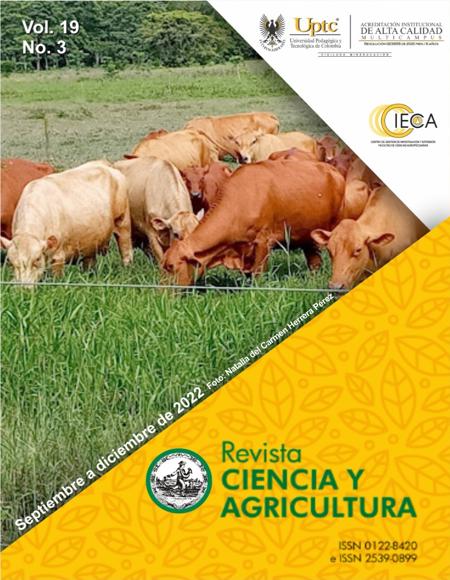Persistence of Bacillus thuringiensis and Bacillus pumilus potential biological control agents of the coffee berry borer under field conditions of Puerto Rico

Abstract
Field trials were conducted in two years to evaluate persistence of B. thuringiensis and Bacillus pumilus under field conditions. Strains of B. thuringiensis (3971) and B. pumilus (4185) were isolated from coffee agro-ecosystem in Puerto Rico. Field trials consisted in plots of nine coffee trees arranged in a randomized complete block design, sprayed with Bt-3971 and Bp-4185 at 108, 109, or 1010 colony forming units CFU ml-1 or non-inoculated. In year 1, B. thuringiensis and B. pumilus survived up to six months after inoculation. Monitoring carried out during year 2, re-confirmed the survival of Bt-3971 and Bp-4185 inoculated in coffee trees under field conditions. Overall, Bt-3971 had significantly more recovery rates than Bp-4185. However, the higher bacterial recoveries were 1.24x1013 CFU ml-1 in coffee trees treated with Bt-3971 and 2.48x1013 CFU ml-1 in coffee trees treated with Bp-4185 in year 1 and year 2, respectively, both sprayed with 1010 spores ml-1. B. thuringiensis (3971) and B. pumilus (4185) isolated from coffee fields of Puerto Rico are well adapted to the environmental conditions of the island, and are valuable biological control agents against coffee berry borer.
Keywords
Coffee Berry Borer, Bacillus thuringiensis, Bacillus pumilus, Colony forming Units
References
- Allgeier S, Kästel A, Brühl C A. 2019. Adverse effects of mosquito control using Bacillus thuringiensis var. israelensis: Reduced chironomid abundances in mesocosm, semi-field and field studies. Ecotox Environ Safe. 169, 786-796.
- Baró RY and Dos Santos Nascimento R. 2009. Caracterización de cepas de Bacillus thuringiensis Berliner y actividad biológica hacia Spodoptera frugiperda (JE smith)(Lepidoptera: Noctuidae) y Anticarsia gemmatalis Hübner (Lepidoptera: Noctuidae). Fitosanidad 13(3):187-92.
- Marino-Cardenas YA, García-Peña JM, Vega VJ, Verle-Rodrigues JC, Bayman P. 2018. After the fall: Did coffee plants in Puerto Rico survive the 2017 hurricanes? Agric Ecosyst Environ 266:10-6.
- Meinzer FC, Grantz DA, Goldstein G, Saliendra NZ. 1990. Leaf water relations and maintenance of gas exchange in coffee cultivars grown in drying soil. Plant Physiol 94(4):1781-7.
- Molina CA, Caña Roca JF, Osuna A, Vilchez S. year 1. Selection of Bacillus pumilus strain highly active against Ceratitis capitata (Wiedemann) larvae. App Environ Microbiol 76 (5): 1320-27.
- Powell KA and Jutsum AR. 1993. Technical and commercial aspects of biocontrol products. Pestic Sci 37(4):315-21.
- Allgeier, S., Kästel, A., Brühl, C. A. (2019). Adverse effects of mosquito control using Bacillus thuringiensis var. israelensis: reduced chironomid abundances in mesocosm, semi-field and field studies. Ecotoxicology and Environmental Safety, 169, 786-796. https://doi.org/10.1016/j.ecoenv.2018.11.050
- Baró Robaina, Y., Dos Santos Nascimento, R. (2009). Caracterización de cepas de Bacillus thuringiensis Berliner y actividad biológica hacia Spodoptera frugiperda (JE Smith) (Lepidoptera: Noctuidae) y Anticarsia gemmatalis Hübner (Lepidoptera: Noctuidae). Fitosanidad, 13(3), 187-192. http://scielo.sld.cu/scielo.php?script=sci_arttext&pid=S1562-30092009000300005&lng=es&tlng=es
- Barrera, J. F., & Arroyo, L. (2007). Control biológico de insectos plaga en el sureste de México. Teoría y aplicación del control biológicop. 201-233.Barrera JF and JI López-Arroyo. 2007. Control biológico de insectos plaga en el sureste de México, pp. 201-233. In: L. A. Rodríguez-del-Bosque y H. C. Arredondo-Bernal (eds.), Teoría y Aplicación del Control Biológico. Sociedad Mexicana de Control Biológico, México. 303 p. https://www.ecosur.mx/ecoconsulta/indicadores/detalles.php?id=12467&bdi=131&name=Control%20biol%C3%B3gico%20de%20insectos%20plaga%20en%20el%20sureste%20de%20M%C3%A9xico
- Bravo, A., Gill, S. S., Soberon, M. (2007). Mode of action of Bacillus thuringiensis Cry and Cyt toxins and their potential for insect control. Toxicon, 49(4), 423-435. https://doi.org/10.1016/j.toxicon.2006.11.022Bravo A, Gill SS, and Soberon M. 2007. Mode of action of Bacillus thuringiensis Cry and Cyt toxins and their potential for insect control. Toxicon, 49(4), pp.423-435.
- Damon, A. (2000). A review of the biology and control of the coffee berry borer, Hypothenemus hampei (Coleoptera: Scolytidae). Bulletin of entomological researchBull Entomol Res 90(6):453-65. https://doi.org/10.1017/S0007485300000584
- De la Rosa, W., Figueroa, M., Ibarra, J. E. (2005). Selection of Bacillus thuringiensis strains native to Mexico active against the coffee berry borer Hypothenemus hampei (Ferrari) (Coleoptera: Curculionidae: Scolytinae). Vedalia 12:3-9. https://revistas.ucr.ac.cr/index.php/rbt/article/view/15412
- http://cfcs.eea.uprm.edu/Presentations/Farmers%20Forum/Industrial%20del%20Cafe%20-%20Importancia%20para%20la%20zona%20montanosa.pdf (Accessed on 3-19-2019)
- Kergunteuil, A., Bakhtiari, M., Formenti, L., Xiao, Z., Defossez, E.,. and Rasmann, S. (, 2016). Biological control beneath the feet: a review of crop protection against insect root herbivores. Insects, 7(4), p.70. DOI: https://doi.org/10.3390/insects7040070
- Mariño, Y. A., García-Peña, J. M., Vega, V. J., Verle-Rodrigues, J. C., Bayman, P. (2018). After the fall: did coffee plants in Puerto Rico survive the 2017 hurricanes? Agriculture Ecosystems and Environment 266:10-6. https://doi.org/10.1016/j.agee.2018.07.011
- Molina, C. A., Caña-Roca, J. F., Osuna, A., Vilchez, S. (2010). Selection of a Bacillus pumilus strain highly active against Ceratitis capitata (Wiedemann) larvae. Applied and Environmental Microbiology, 76(5), 1320-1327. https://doi.org/10.1128/AEM.01624-09
- Monroig-Ingles, M. 2015. Situación Industria Café en Puerto Rico. In:https://academic.uprm.edu/mmonroig/HTMLobj-1670/Situacion_Cafe_en_PR_2015F.pdf (Accessed on 3-19-2019)
- Nicholson, W. L. (2002). Roles of Bacillus endospores in the environment. Cellular and Molecular Life Sciences CMLS 59(3):410-6. https://doi.org/10.1007/s00018-002-8433-7
- Robles, F. and Ferré-Sadurní, L. (2017). Puerto Rico’s agriculturea and farmers decimated by Maria. New York Times, Sept.24. In: https://www.nytimes.com/2017/09/24/us/puerto-rico-hurricane-maria-agriculture-.html (Accessed on: 3/19/2019).
- Rullan, B. I. (2006). Industria del Café, Importancia para la Zona Montañosa. Asociación de Agricultores de Puerto Rico. Conferencia Estación Experimental Agrícola.
- Sánchez, J. M., and Peña, J. J. (2000). Persistencia de esporas de Bacillus thuringiensis en hojas de maíz, de frijol y en el suelo. Terra Latinoamericana; 18(04):325-331. https://www.redalyc.org/articulo.oa?id=57318406
- Smith, R. A., and Couche, G. A. (1991). The phylloplane as a source of Bacillus thuringiensis variants. Applied Environmental Microbiology. 57(1):311-5. DOI: https://doi.org/10.1128/aem.57.1.311-315.1991
- Stahly, D. P., Andrews, R. E., and Yousten, A. A. (1992). The genus Bacillus—Insect pathogens. Pages 1697-1745 in: The Prokaryotes. A Handbook on the Biology of Bacteria: Ecophysiology, Isolation, Identification, Applications. 2nd ed. Springer-Verlag, New York.
- Vazquez, D., Zapata, M., and Bolaños, C. 2020. Potencial de Bacillus pumilus Bp4185 y Bacillus thuringiensis Bt3971 para el biocontrol de la broca del café. Biotecnología Vegetal, 20(3), 167-176. http://scielo.sld.cu/pdf/bvg/v20n3/2074-8647-bvg-20-03-167.pdf
- Vega, F. E., Infante, F., Castillo, A., Jaramillo, J. (2009). The coffee berry borer, Hypothenemus hampei (Ferrari) (Coleoptera: Curculionidae): A short review, with recent findings and future research directions. Terrestrial Arthropod Reviews 2(2):129. http://www.ico.org/event_pdfs/cbb/presentations/vega_review.pdf
